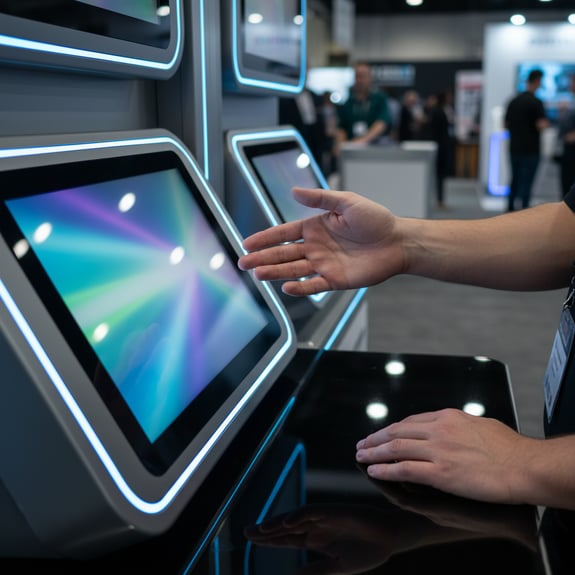You’ve invested months and a significant budget to create the perfect experiential booth. It’s visually stunning, technologically impressive, and perfectly on-brand. But as the show doors open and attendees begin to fill the aisles, the most critical – and most vulnerable – part of your brand experience is about to begin: the human interaction.
It’s a hard truth of the trade show floor that even the most beautifully designed exhibit can underperform if the booth staff isn't prepared. The single biggest mistake we see brands make is treating their on-site team like presenters, there to simply broadcast information. To truly capitalize on your investment, you need to cultivate a team of consultants – professionals trained to listen, diagnose, and guide. This strategic shift can mean the difference between collecting a list of names and building a pipeline of qualified opportunities.
The "Presenter" Trap: Are You Talking At Attendees?
What does the "presenter" mindset look like in practice? It’s often the default mode for an untrained team. They might stand passively, waiting to be approached. When an attendee does engage, the presenter’s first instinct is often to launch into a practiced spiel, listing off features and benefits without first understanding who they’re talking to or what problems that person is trying to solve.
While well-intentioned, this one-way communication is rarely effective. It puts the attendee on the defensive and fails to establish a genuine connection or uncover a real need. The result is a superficial conversation that rarely leads to a meaningful business opportunity.
The "Consultant" Mindset: Diagnosing Before You Prescribe
A consultant operates from a completely different perspective. Their primary goal isn’t to talk; it’s to listen and understand. Like a good doctor, they diagnose before they prescribe a solution. A consultant in your booth is trained to:
- Proactively and warmly engage attendees.
- Ask insightful questions to uncover their challenges, goals, and motivations.
- Actively listen to the answers to build rapport and identify genuine needs.
- Only then connect the attendee’s specific problem to a relevant feature or benefit of your product or service.
This approach transforms a sales pitch into a helpful, collaborative conversation, immediately building trust and positioning your team member as a valuable resource.
Actionable Tip #1: Master the Art of the Discovery Question
The foundation of the consultant mindset is the discovery question. These are open-ended questions designed to get the attendee talking about themselves and their business, rather than closed-ended questions that yield a simple "yes" or "no."
Instead of asking: "Can I tell you about our new platform?"
Try asking: "What's the biggest challenge your team is facing with [their area of business] right now?"
Instead of asking: "Are you familiar with our company?"
Try asking: "What are you hoping to discover at the show today that would make this a huge win for your trip?"
Train your team to ask questions that focus on the attendee's pains, goals, and needs. This immediately shifts the dynamic and provides the raw material for a valuable conversation.
Actionable Tip #2: Train for Active Listening
Asking a great question is only half the battle. Your team must be trained to actively listen to the answer. This means listening to understand, not just waiting for their turn to talk.
- Listen More, Talk Less: Encourage staff to follow the 80/20 rule – let the attendee do 80% of the talking in the initial discovery phase.
- Paraphrase and Confirm: Teach them to repeat back what they've heard in their own words. For example, "So, if I'm understanding correctly, your biggest bottleneck is X, and it's causing Y problem for your team?" This shows you're listening and ensures you've correctly identified the core issue.
- Ask Follow-Up Questions: Based on their answer, train your team to dig a little deeper. Questions like "Can you tell me more about that?" or "How is that currently impacting your workflow?" can uncover deeper needs.
Actionable Tip #3: Connect Solutions Directly to Problems
Once your team has successfully uncovered a specific pain point through questioning and listening, now is the time to introduce your solution. The key is to frame it as a direct answer to the problem they just shared.
For example: "You mentioned that tracking your team's remote assets is a major challenge. Our new platform was designed specifically for that, with a real-time dashboard that gives managers a single view of all assets in the field. Let me quickly show you how that works."
This approach feels helpful and relevant, not pushy. You are no longer just listing features; you are providing a tailored solution to a stated problem.
The Impact on Lead Qualification and ROI
This consultant-based approach fundamentally changes the nature of lead capture. Instead of just a name and an email, a lead now comes with a rich set of context. Your staff can add notes like: "Spoke with Jane from ABC Corp. Her team is struggling with inefficient workflow (Pain Point). She was very interested in our automated reporting feature (Solution). She is the decision-maker for her department and has a budget meeting next month (Qualification)."
This is a sales-qualified lead (SQL), not a cold contact. It allows your sales team to conduct highly relevant, personalized follow-up, dramatically increasing the chances of conversion and directly proving the ROI of your trade show investment.
Your exhibit sets the stage, but your people deliver the performance. Investing in training your booth staff to shift from presenters to consultants is one of the single most effective actions you can take to ensure your beautiful booth produces beautiful results.
At Exhibit Options, we believe a holistic event strategy includes empowering your team for success. Let's talk about how to integrate world-class staff engagement into your next world-class exhibit.



COMMENTS